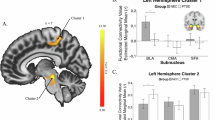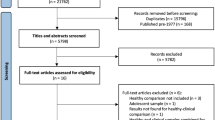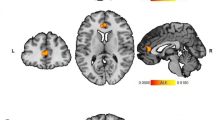Abstract
Animal models of early life stress (ELS) are characterized by augmented amygdala response to threat and altered amygdala-dependent behaviors. These models indicate the amygdala is a heterogeneous structure with well-differentiated subnuclei. The most well characterized of these being basolateral (BLA) and central nucleus (CeA). Parallel human imaging findings relative to ELS also reveal enhanced amygdala reactivity and disrupted connectivity but the influence of ELS on amygdala subregion connectivity and modulation of emotion is unclear. Here we employed cytoarchitectonic probability maps of amygdala subregions and Granger causality methods to evaluate task-based intra-amygdaloid and extra-amygdaloid connectivity with the network underlying implicit regulation of emotion in response to unconditioned auditory threat in healthy controls with ELS (N=20) and without a history of ELS (N=14). Groups were determined by response to the Childhood Trauma Questionnaire and threat response determined by unpleasantness ratings. Non-ELS demonstrated narrowly defined BLA-driven intra-amygdaloid paths and concise orbitofrontal cortex (OFC)–CeA-driven extra-amygdaloid connectivity. In contrast, ELS was associated with extensive and robust CeA-facilitated intra- and extra-amygdaloid paths. Non-ELS findings paralleled the known anatomical organization and functional relationships for both intra- and extra-amygdaloid connectivity, while ELS demonstrated atypical intra- and extra-amygdaloid CeA-dominant paths with compensatory modulation of emotion. Specifically, negative causal paths from OFC/BA32 to BLA predicted decreased threat response among non-ELS, while a unique within-amygdala path predicted modulation of threat among ELS. These findings are consistent with compensatory mechanisms of emotion regulation following ELS among resilient persons originating both within the amygdala complex as well as subsequent extra-amygdaloid communication.
Similar content being viewed by others
Log in or create a free account to read this content
Gain free access to this article, as well as selected content from this journal and more on nature.com
or
References
Abler B, Roebroeck A, Goebel R, Schfnfeldt-Lecuona C, Hole G, Walter H (2006). Investigating directed influences between activated brain areas in a motor-response task using fMRI. Magn Reson Imaging 24: 181–185.
Amaral DG, Price JL, Pitkanen A, Carmichael ST (1992). Anatomical organization of the primate amygdaloid complex. In: Aggleton J (ed). The Amygdala: neurobiological Aspects of Emotion, Memory, and Mental Dysfunction. Wiley-Liss: New York, NY, USA, pp 1–66.
Amunts K, Kedo O, Kindler M, Pieperhoff P, Mohlberg H, Shah NJ et al (2005). Cytoarchitectonic mapping of the human amygdala, hippocampal region and entorhinal cortex: intersubject variability and probability maps. Anat Embryol (Berl) 210: 343–352.
Bach D, Behrens T, Garrido L, Weiskopf N, Dolan R (2011). Deep and superficial amygdala nuclei projections revealed in vivo by probabilistic tractography. J Neurosci 31: 618–623.
Banks S, Eddy K, Angstadt M, Nathan P, Phan KL (2007). Amygdala-frontal connectivity during emotion regulation. Soc Cogn Affect Neurosci 2: 303–312.
Bernstein D, Fink LA (1998) Manual for the Childhood Trauma Questionnaire. The Psychological Corporation: New York, NY, USA.
Brown VM, LaBar KS, Haswell CC, Gold AL, McCarthy G, Morey RA (2014). Altered resting-state functional connectivity of basolateral and centromedial amygdala complexes in posttraumatic stress disorder. Neuropsychopharmacology 39: 351–359.
Dannlowski U, Stuhrmann A, Beutelmann V, Zwanzger P, Lenzen T, Grotegerd D et al (2012). Limbic scars: long-term consequences of childhood maltreatment revealed by functional and structural Magn Reson Imaging. Biol Psychiatry 71: 286–293.
Dannlowski U, Kugel H, Huber F, Stuhrmann A, Redlich R, Grotegerd D et al (2013). Childhood maltreatment is associated with an automatic negative emotion processing bias in the amygdala. Hum Brain Mapp 34: 2899–2909.
Davis M (2006). Neural systems involved in fear and anxiety measured with fear-potentiated startle. Am Psychol 61: 741–756.
Duvarci S, Pare D (2007). Glucocorticoids enhance the excitability of principal basolateral amygdala neurons. J Neurosci 27: 4482–4491.
Eickhoff SB, Stephan KE, Mohlberg H, Grefkes C, Fink GR, Amunts K et al (2005). A new SPM toolbox for combining probabilistic cytoarchitectonic maps and functional imaging data. Neuroimage 25: 1325–1335.
Etkin A, Prater K, Schatzberg A, Menon V, Greicius M (2009). Disrupted amygdalar subregion functional connectivity and evidence of a compensatory network in generalized anxiety disorder. Arch Gen Psychiatry 66: 1361–1372.
Fink LA, Bernstein D, Handelsman L, Foote J, Lovejoy M (1995). Initial reliability and validity of the childhood trauma interview: a new multidimensional measure of childhood interpersonal trauma. Am J Psychiatry 152: 1329–1335.
First MB, Spitzer RL, Gibbon M, Williams JBW (2002). Structured Clinical Interview for DSM-IV-TR Axis Disorders, Research Version, Non-Patient Edition (SCID-I/NP). Biometrics Research, New York State Psychiatric Institute: New York, NY, USA.
Freese J, Amaral D (2009). Neuroanatomy of the primate amygdala. In: Whalen P, Phelps E, editors. The human amygdala. New York, Guilford, 3–42.
Gamer M, Zurowski B, Buchel C (2010). Different amygdala subregions mediate valence-related and attentional effects of oxytocin in humans. Proc Natl Acad Sci USA 107: 9400–9405.
Ghashghaei HT, Barbas H (2002). Pathways for emotion: interactions of prefrontal and anterior temporal pathways in the amygdala of the rhesus monkey. Neuroscience 115: 1261–1279.
Ghashghaei HT, Hilgetag CC, Barbas H (2007). Sequence of information processing for emotions based on the anatomic dialogue between prefrontal cortex and amygdala. Neuroimage 34: 905–923.
Granger C (1969). Investigating causal relations by econometric models and cross-spectral methods. Econometrica 37: 424–438.
Grant MM, Cannistraci C, Hollon SD, Gore J, Shelton R (2011). Childhood trauma history differentiates amygdala response to sad faces within MDD. J Psychiatr Res 45: 886–895.
Grant MM, Hadley J, Hutcheson N, Shelton R, Sreenivasan K, Deshpande G (2014). Early life trauma and directional brain connectivity in major depression. Hum Brain Mapp 35: 4815–4826.
Green JG, McLaughlin KA, Berglund PA, Gruber MJ, Sampson NA, Zaslavsky AM et al (2010). Childhood adversities and adult psychiatric disorders in the national comorbidity survey replication I: associations with first onset of DSM-IV disorders. Arch Gen Psychiatry 67: 113–123.
Gross JJ, Thomspons RA (2007). Emotion regulation: conceptual foundations. In: Gross JJ (ed). Handbook of Emotion Regulation. Guilford Press: New York, NY, USA, pp 3–24.
Havlicek M, Friston K, Jan J, Brazdil M, Calhoun V (2011). Dynamic modeling of neuronal responses in fMRI using cubature Kalman filtering. Neuroimage 56: 2109–2128.
Kalisch R (2009). The functional neuroanatomy of reappraisal: time matters. Neurosci Biobehav Rev 33: 1215–1226.
LaBar KS, LeDoux JE (2011). Coping with danger: the neural basis of defensive behavior and fearful feelings. Compr Physiol 17: 139–154.
LeDoux JE (2007). The amygdala. Curr Biol 17: R868–R874.
Marusak HA, Martin KR, Etkin A, Thomason ME, Vaitl D, Stark R (2014). Childhood trauma exposure disrupts the automatic regulation of emotional processing. Neuropsychopharmacology (in press).
Merz CJ, Tabbert K, Schweckendiek J, Klucken T, Vaitl D, Stark R et al (2010). Investigating the impact of sex and cortisol on implicit fear conditioning with fMRI. Psychoneuroendocrinology 35: 33–46.
Merz CJ, Wolf OT, Schweckendiek J, Klucken T, Vaitl D, Stark R (2013). Stress differentially affects fear conditioning in men and women. Psychoneuroendocrinology 38: 2529–2541.
Meyer-Lindenberg A, Olsen R, Kohn P, Brown T, Egan MF, Weinberger DR et al (2005). Regionally specific disturbance of dorsolateral prefrontal-hippocampal functional connectivity in schizophrenia. Arch Gen Psychiatry 62: 379–386.
Morris JS, Buchel C, Dolan RJ (2001). Parallel neural responses in amygdala subregions and sensory cortex during implicit fear conditioning. Neuroimage 13: 1044–1052.
Philip NS, Sweet LH, Tyrka AR, Price LH, Bloom RF, Carpenter LL (2013). Decreased default network connectivity is associated with early life stress in medication-free healthy adults. Eur Neuropsychopharmacol 23: 24–32.
Phillips ML, Ladouceur CD, Drevets WC (2008). A neural model of voluntary and automatic emotion regulation: implications for understanding the pathophysiology and neurodevelopment of bipolar disorder. Mol Psychiatry 13: 829–833–857.
Price JL, Drevets WC (2010). Neurocircuitry of mood disorders. Neuropsychopharmacology 35: 192–216.
Quirk G, Likhtik E, Pelletier J, Pare D (2003). Stimulation of medial prefrontal cortex decreases the responsiveness of central amygdala output neurons. J Neurosci 23: 8800–8807.
Radley JJ, Sisti HM, Hao J, Rocher AB, McCall T, Hof PR et al (2004). Chronic behavioral stress induces apical dendritic reorganization in pyramidal neurons of the medial prefrontal cortex. Neuroscience 125: 1–6.
Rodrigues SM, LeDoux JE, Sapolsky RM (2009). The influence of stress hormones on fear circuitry. Annu Rev Neurosci 32: 289–313.
Rosenkranz JA, Venheim ER, Padival M (2010). Chronic stress causes amygdala hyperexcitability in rodents. Biol Psychiatry 67: 1128–1136.
Roy AK, Shehzad Z, Margulies DS, Kelly AM, Uddin LQ, Gotimer K et al (2009). Functional connectivity of the human amygdala using resting state fMRI. Neuroimage 45: 614–626.
Schiller D, Levy I, Niv Y, LeDoux JE, Phelps EA (2008). From fear to safety and back: reversal of fear in the human brain. J Neurosci 28: 11517–11525.
Shin LL, Liberzon I (2010). The neurocircuitry of fear, stress and anxiety disorders. Neuropsychopharmacology 35: 169–191.
Shin LM, Wright CI, Cannistraro PA, Wedig MM, McMullin K, Martis B et al (2005). A functional Magn Reson Imaging study of amygdala and medial prefrontal cortex responses to overtly presented fearful faces in posttraumatic stress disorder. Arch Gen Psychiatry 62: 273–281.
Silvers JA, Wager TD, Weber J, Ochsner KN (2014). The neural bases of uninstructed negative emotion modulation. Soc Cogn Affect Neurosci 10: 10–18.
Stein JL, Wiedholz LM, Bassett DS, Weinberger DR, Zink CF, Mattay VS et al (2007). A validated network of effective amygdala connectivity. Neuroimage 36: 736–745.
Treadway MT, Grant MM, Ding Z, Hollon SD, Gore JC, Shelton RC (2009). Early adverse events, HPA activity and rostral anterior cingulate volume in MDD. PloS One 4: e4887.
Vyas A, Bernal S, Chattarji S (2003). Effects of chronic stress on dendritic arborization in the central and extended amygdala. Brain Res 965: 290–294.
Wheelock MD, Sreenivasan KR, Wood KH, Ver Hoef LW, Desphande G, Knight DC (2014). Threat-related learning relies on distinct dorsal prefrontal cortex network connectivity. Neuroimage 102 (Pt 2): 904–912.
Williams LM, Kemp AH, Felmingham K, Barton M, Olivieri G, Peduto A et al (2006). Trauma modulates amygdala and medial prefrontal responses to consciously attended fear. Neuroimage 29: 347–357.
Wood KH, Ver Hoef LW, Knight DC (2012). Neural mechanisms underlying the conditioned diminution of the unconditioned fear response. Neuroimage 60: 787–799.
Zald DH (2003). The human amygdala and the emotional evaluation of sensory stimuli. Brain Res Brain Res Rev 41: 88–123.
Acknowledgements
We would like to thank Baxter Rogers and the staff of the Vanderbilt University Institute of Imaging Science (VUIIS) for their assistance with imaging methods; Lauren Johnson, Joshua Shumen, Sara Robicheaux, and Samineh Hiebert for their assistance with data acquisition and general administrative assistance.
Author information
Authors and Affiliations
Corresponding author
Additional information
Supplementary Information accompanies the paper on the Neuropsychopharmacology website
Supplementary information
Rights and permissions
About this article
Cite this article
Grant, M., Wood, K., Sreenivasan, K. et al. Influence of Early Life Stress on Intra- and Extra-Amygdaloid Causal Connectivity. Neuropsychopharmacol 40, 1782–1793 (2015). https://doi.org/10.1038/npp.2015.28
Received:
Revised:
Accepted:
Published:
Issue date:
DOI: https://doi.org/10.1038/npp.2015.28
This article is cited by
-
Negative family and interpersonal relationship are associated with centromedial amygdala functional connectivity alterations in adolescent depression
European Child & Adolescent Psychiatry (2024)
-
FMRI hemodynamic response function (HRF) as a novel marker of brain function: applications for understanding obsessive-compulsive disorder pathology and treatment response
Brain Imaging and Behavior (2021)
-
Deterioration from healthy to mild cognitive impairment and Alzheimer’s disease mirrored in corresponding loss of centrality in directed brain networks
Brain Informatics (2019)
-
Does prenatal stress alter the developing connectome?
Pediatric Research (2017)
-
Adversity-induced relapse of fear: neural mechanisms and implications for relapse prevention from a study on experimentally induced return-of-fear following fear conditioning and extinction
Translational Psychiatry (2016)



